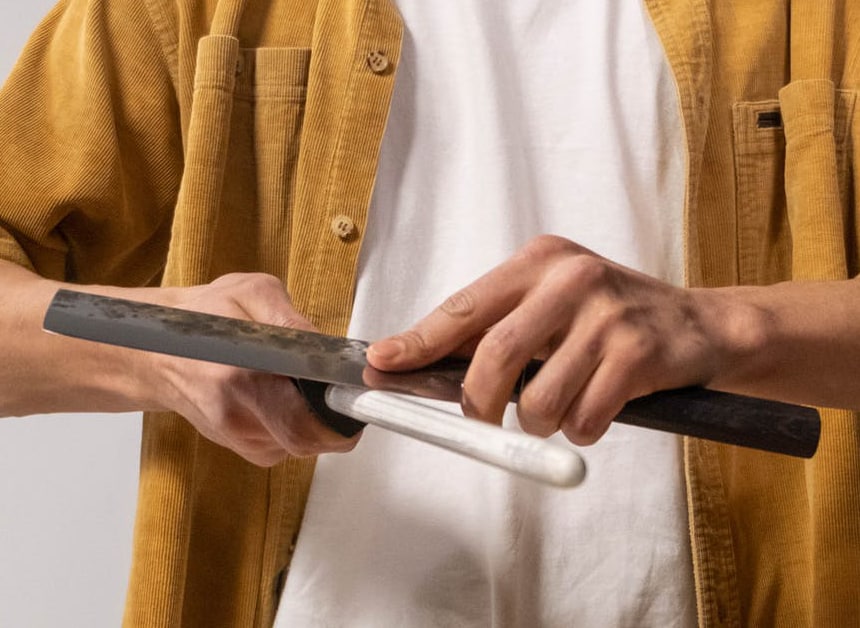Carbon steel is subject to rust, just like most other types of steel (outside of stainless). The best way to keep your kitchen blades from rusting is to take good care of them by washing, cleaning, drying, applying oil, and potentially adding a patina.
Vinegar will remove rust from carbon steel, but you can’t just set a carbon steel knife in a vat of vinegar and expect it to be clean as a whistle the next day. You will need white vinegar, salt and a neutralizing agent such as baking soda.
There’s a procedure for cleaning carbon steel using vinegar and you should never go with just straight vinegar anyways. If rust has formed on your carbon steel blades, it will take some work to get it off.
Looking for a rust-resistant high carbon knife?
You can take a look at my recommendation, the Dalstrong Quantum on Amazon here (opens new tab).
Can You Clean Carbon Steel with Vinegar?
You can clean carbon steel with vinegar and, vinegar is pretty effective at helping you remove the rust. Vinegar is a diluted form of acetic acid. While it’s not even close to being purely acetic acid—its actually in the neighborhood of 5%—it’s enough to get a reaction with rust.
Rust is the result of iron’s interaction with water and not matter how pure your carbon steel is, there is plenty of iron in there. In fact, there’s more than enough iron to start the oxidation process that results in rust.
When acetic acid and rust meet, they begin their own process, which is called neutralization. When you sit down with a bottle of vinegar and your carbon steel, you’ll need more than just the vinegar, especially if you want to expedite the process.
How to Remove Rust Using Vinegar
First, you want to put together everything that you will need to make this process a breeze. You’ll want a five-gallon bucket, one cup of salt, and white vinegar. You can use apple cider vinegar, but the white is just a little stronger for what your objective is.
- Fill your bucket with one gallon white vinegar
- Add one cup of table salt and stir it in well
- Submerge (blade only) in the solution
- Let sit for 30 minutes to 12 hours
- When you see the rust flaking off, scrub the blade with mild detergent and rinse
- Neutralize the knife
The reason for the twelve-hour window is that there is no telling how long it will take. However, if you see the rust flaking, you can pull the blade out and start scrubbing.
You also want to neutralize the acid from the vinegar by mixing a gallon of water with a cup of baking soda. Set the blade back in there for at least 12 minutes.
Can Vinegar Corrode Steel?
It can and will, especially if the steel is left within the solution and it’s not neutralized afterward. As mentioned above, vinegar is an acetic acid and, although carbon steel is extremely strong, it won’t stand up to acid forever.
The eventual result will be visible pitting in the steel, especially around the soft cutting edge, where you definitely don’t want it to pit, especially if it’s so deep that it’s difficult to sharpen the pit out of the edge.
Does Carbon Steel Rust Easily?
Not necessarily, as it depends on the level of carbon alloy in the steel. Low levels of carbon are often still categorized as carbon steel, however, the blades with lower levels of carbon are much more resilient to rust and corrosion than blades with a higher carbon composition.
That doesn’t mean that high carbon steel blades will rust easily, because they won’t. It will just rust quicker than low alloy carbon. Letting a high carbon blade sit in a sink full of water overnight is never a good idea.
How Do You Keep Carbon Steel from Rusting?
This is pretty simple and all it comes down to is preventative maintenance. You want to clean and dry your knives after each and every use. After every third or fourth use, apply some blade oil to all of your carbon steel knives.
You can also form a patina on your blades, if you don’t mind the unique look that it gives them. To do this, you can use potatoes, mustard or even coffee. Brew a strong pot of coffee and let it completely cool.
Place you knife in a cup, with a sponge at the bottom of the cup. Poor the cool coffee into the cup, covering the blade all the way to the handle. Leave the knife in there for a full, 24-hours. When you pull it out, it will look different but it will be far more resistant to rust.

